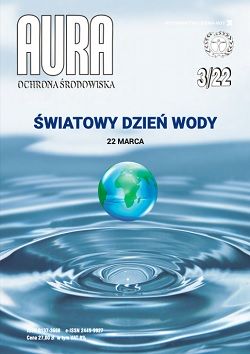
- We must look at water comprehensively
On March 22, we celebrate the World Water Day, established 30 years ago by the UN General Assembly. It is supposed to remind us of the great role of water and of the enormous threat posed by the shortage of its resources. Every year, the Polish Academy of Sciences on this day organizes a scientific conference devoted to the issues, which each time refer to a different slogan of the World Water Day celebration. - Adaptation to climate change as a priority of the National Fund for Environmental Protection and Water Management
Human-induced climate change is increasingly occurring in an extreme form. Mitigating their effects depends on taking rational measures in the field of sustainable development, spatial planning, urban planning, as well as proper management and management of water resources. - Water as a global and national problem
Access to clean water is a fundamental human right. Its resources are essential for life, sustainable development and the functioning of ecosystems. The Water Framework Directive (WFD), in force since 2000, indicated that water is not a commercial product, but our heritage. - Groundwater - Hidden Potential for Humanity
Although groundwater is invisible, its impact is everywhere. Under our feet, they are like a hidden treasure, because almost all fresh water in the world is groundwater, and as climate changes intensify, they will become more and more important for our existence. We must do everything to be able to manage this valuable resource in a sustainable way. Groundwater may be out of sight but must not be overlooked in water management and in no way be neglected - World Water Day-2022. The All-Ocean, which covers 71 percent. of the earth's surface, it contains almost 98 percent. the waters of our planet. It occurs in various places and forms. However, a small percentage of it can be consumed by people and it is only about 0.3%. The remaining 99.7 percent is the water found in the oceans and seas, which, due to its high salinity, is not widely used for human consumption. Although water desalination methods exist, they are technologically too expensive and energy-consuming to be used on an industrial scale. - Research on rivers and canals using citizen science
Vegetation is critical in the aquatic environment. More and more scientific research is concerned with its influence on the processes taking place in and in the vicinity of river beds. One of the pilot activities of the BRITEC project to bring citizenship science ( Citizen Science) to schools was dedicated to observing the seasonal changes in river and coastal vegetation and the microclimate of river valleys. As part of the project, students, under the supervision of teachers, monitored vegetation and meteorological conditions near rivers or other watercourses in various locations. The involvement of schools from different parts of Poland made it possible to monitor changes taking place in various types of rivers and canals. The observations provided data for further scientific analysis. - Drinking water from the seas and oceans
A breakthrough technique of nanomembranes , due to simple filtration, by gravity, is able to purify and desalinate sea water without the use of energy and pressure. The world's first such innovative technology was developed by young scientists and engineers from Poland, under the leadership of Bartosz Kruszka. Mobile devices with nanomembranes can be placed anywhere and in any climate zone, e.g. on beaches in poor African or Asian villages. This breakthrough technique can effectively replace large and expensive installations that many countries in the world cannot afford. - Adoption of updates of flood risk management plans is getting closer
Currently, inter-ministerial consultations on updated flood risk management plans (aPZRP) are carried out. The legislative procedure is aimed at adopting the plans in the form of a regulation of the minister responsible for water management. They provide for a total of over 1.1 thousand. activities in the river basin districts, mainly the Vistula and the Odra. This is the final phase of the design work started in 2020. nationwide public consultations attended by over 2.5 thousand stakeholders and over 800 applications and comments were submitted. Updated plans, already in the form of a regulation, will be sent in the form of a report to the European Commission. - Grays
There was a time when a glass of wormwood could be easily eaten with a hare pate. For every time hunters went out into the forest, they had rich loot. The hunters seldom returned home empty-handed. The game was in the dirt, and the hare's ears were sticking out from under every bore. The grays were ubiquitous. They nested and multiplied near agricultural crops, pastures and meadows. - Unusual ficus and sweet figs
Ficus (Ficus) is a genus of the mulberry family, it includes about 800 species, mostly trees, widespread in the tropical and subtropical climate zone. They are characterized by an interesting structure and pollination ecology of flowers. The flowers are dioecious, very small, located inside the hollow and fleshy axis of the inflorescence. They are pollinated by tiny wasps that lay their eggs for some flower ovaries, pollinating others. There is a phenomenon of symbiosis between the insect and the plant. After pollination, the axis of the inflorescence grows to form a pseudo-fruit, i.e. a fig. The actual fruit are small, hard stones that we feel when eating figs. - Ecological solutions for agriculture and industry
Over half a century of experience in the industry, specialist knowledge and innovative solutions make the international concern WOLF System a leading producer of reinforced concrete tanks and silos in Europe for storing loose materials, animal manure and water collection. High-class concretes with chemical resistance and special steel guarantee their strength and longevity as well as environmentally safe storage of liquid fertilizers, manure and sewage. These tanks effectively prevent the penetration of toxic and harmful leachates to the ground and surface waters.
AURA Ochrona Środowiska (AURA Environmental Protection) - the whole list






